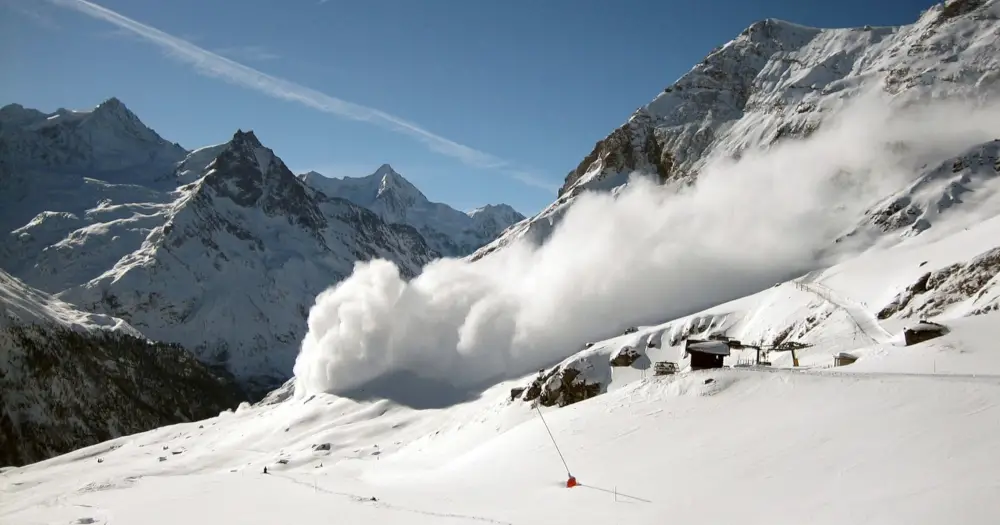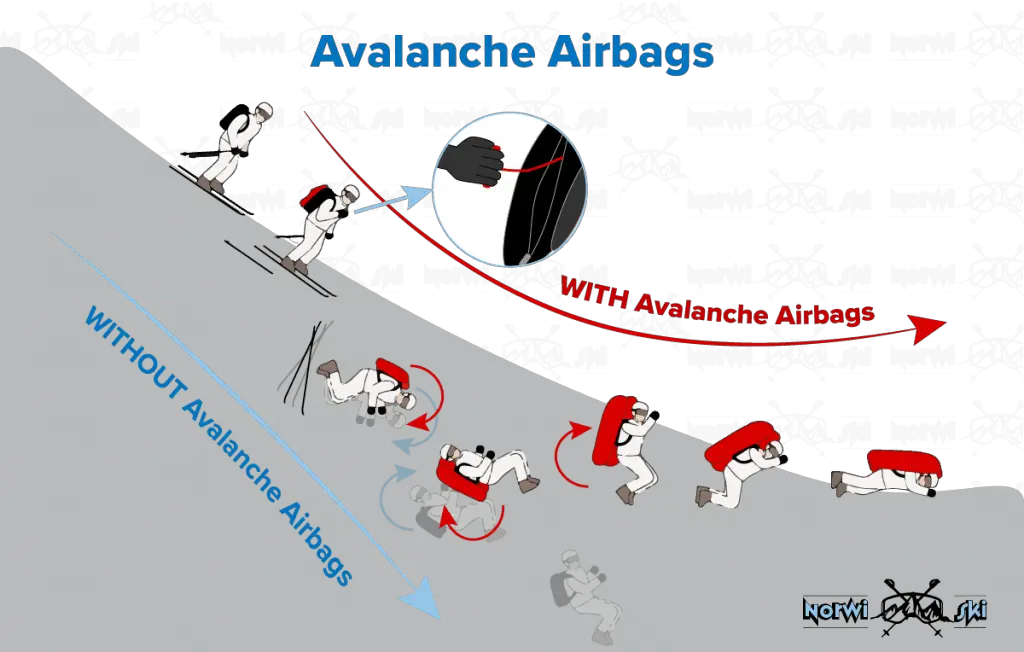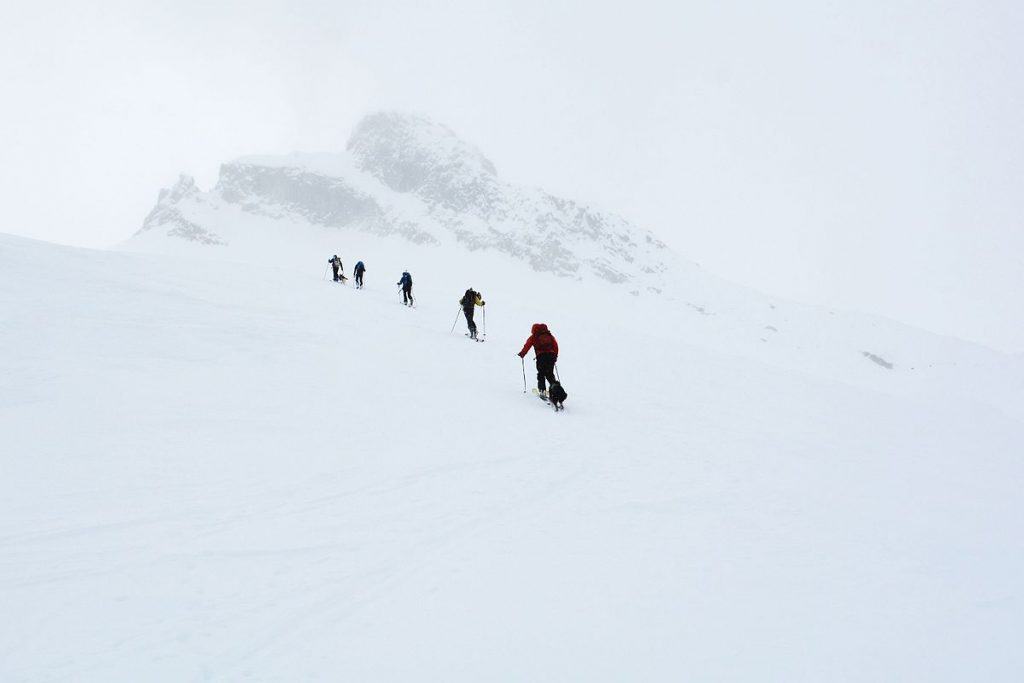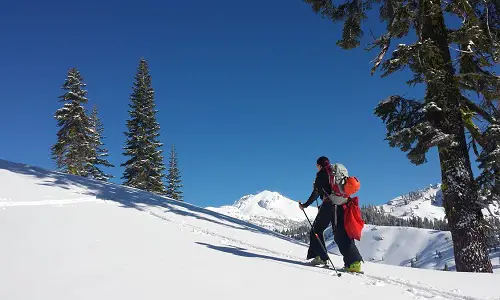Table of Contents
Chances are you do not have to worry about an avalanche as long as you enjoy cross country skiing as most of the cross-country ski trails are considered safe from the hazards of an avalanche. However, not all skiers stay between the safe confines of ski areas. Therefore, a basic understanding of avalanche hazards is a must to know what you can be exposing yourself and others to.
Also, if you want to go ski touring or backcountry skiing, later on, you must know about the avalanche danger scale, the important rules you need to keep in mind to recognize avalanche terrain, and the essential avalanche safety gear you may need to use in case you encounter such situations.
So, let’s make a checklist of what avalanche safety gear you will need:
- Slope Meter
- Snow Study Kit
- Avalanche Transceiver or Beacon
- Portable Shovel
- Avalanche Probe
- Avalanche Airbag
- Radio or Satellite Phone
We will talk about all of these avalanche safety equipment in detail below.

The Avalanche Danger Scale
The avalanche danger scale is something you need to take seriously. There is a 5 point danger ratings that determine how dangerous a certain avalanche is. Let us have a look:
- Low Danger: These are avalanche conditions that are generally safe. Do keep an eye on the unstable snow on isolated terrain.
- Moderate Danger: Evaluate the terrain and snow carefully as there are increased avalanche conditions on the specified terrain.
- Considerable Danger: Dangerous conditions in terms of an avalanche. The occurrence of naturally created avalanches is quite possible and even human-triggered avalanches are also likely to occur. Make sure you evaluate your snowpack and are careful in finding routes.
- High Danger: Skiing or traveling in avalanche terrain is NOT recommended. Extremely dangerous avalanche conditions (both naturally occurring avalanches as well as human-triggered ones) can be encountered.
- Extreme Danger: Stay away from all the avalanche terrains. Both human triggered as well as naturally created avalanches are to take place.
It is crucial for you to understand this scale for detecting avalanche dangers and you should use this information when deciding the area you want to head out to. As per the stats, around 47% of deaths that result due to avalanches happen during the “considerable danger” period – that is nearly half of all fatalities. This means you should not take the last three points lightly and when deciding about your terrain to ski on, avoid terrains that seem not too risky for you but are rated as dangerous or likely to be dangerous.
Essential Avalanche Safety Gear
Prevention is better than cure, so the best way to stay safe in the backcountry is to avoid terrain that is directly or indirectly linked to the avalanche terrain. No matter how far your target terrain seems from the avalanche terrain and no matter how ideal the conditions of a certain terrain seem, make sure you have everything you need or may need before heading out. The key features are evaluating your snowpack, having a good communication system, and having the knowledge of the route.
The following avalanche safety equipment will help you in case of an avalanche and are highly recommended for you to carry with you.
Slope Meters
The best way to prevent encountering an avalanche is to keep away from the avalanche terrain. As the essential part of avalanche safety gear, there is nothing better than conventional slope angle measurements. In winter, go for less steep slopes – ideally slopes that are less than 30 degrees. To be sure, use a slope meter to know how steep a certain slope is. These days smartphones have slope meter apps that help you figure out the exact degrees of a slope. If the slope meter suggests the slope is steeper than what you would like it to be, ski around it without taking any risk.
Radios
You or your skiing buddy can quickly get out of sight as everyone has their own ski pace, but you do not have to get out of communication. With a radio system, you can talk to your ski buddies and let them know if you are stuck somewhere, have lost your way, have encountered a danger, or have a change in plan. Similarly, your radio is a means of communication and information in case any skier ahead of you feels a dangerous terrain and wants to alert you.
When preventing the dangers of avalanche terrain, the radio plays a major role in alerting fellow skiers so that everyone could be safe. It is a must-have when you are heading out, and is the first thing you would want to look for in case you are left stranded or are stuck in an emergency.
Snow Study Kit
The snow kit includes a snow saw, magnifier, crystal card, knotted cord, thermometer, and a waterproof notebook. Snow saws and the knotted cord let you isolate columns of snow to check for stability. You must have seen a skier put his/ her shovel on top of some snow and tap. This is done to perform stability tests on the terrain. The crystal cards along with the magnifier will help you examine the structure of the snow crystals – this is important in determining the level of strength of these crystal bonds in the snow.
With the help of the thermometer, you could measure the temperature gradient in the snowpack. The notebook is for you to note down your findings.
It is important to note that the structure and behavior of snow crystals in one place could be very different than what you observe at another location in the same zone. For this reason, you cannot judge the stability of an entire zone by digging a pit at only one location. Digging the snow pits is part of the many tests you need to carry out to determine the nature of the backcountry snow. It is always a good idea to take an avalanche course which will educate you more on the procedures you can carry out to analyze the stability.
Avalanche Beacon/Transceiver
An avalanche transceiver or a beacon is an electronic device that sends as well as receives radio signals. Suppose your ski partner gets caught up in an avalanche that forces him/ her to sweep hundreds of feet downhill. How are you going to locate him/ her? When skiers leave the trailhead, they need to turn on their beacon and switch it to transmit/ send. In case of an avalanche emergency when he/ she gets buried under piles of snow, other members of the ski group will switch their transceiver/ beacon to receive so that they could locate the victim.
The best part about having a beacon is that all the beacons available in the market today (no matter what brand they are) operate on a universal frequency of 457 kHz. So even if a fellow skier uses a different company of transceiver, you can all send and receive signals for transmitting and searching. These devices are simple and the models offer both digital as well as analog modes, audible and visual signals, as well as the ability to isolate multiple beacon devices in case there are multiple victims. Make sure you know how to use your beacon and should always practice using it before heading out.
It is advisable to replace your beacon after every 5 years. You may notice that your beacon works perfectly well but as a safe practice, five years is the industry standard life given to it. Of course, you can use the old beacon to practice transmitting and receiving signals from your partner. But make sure when you are out and about, you use an avalanche transceiver that is according to the safety standards.
Check Price on BACKCOUNTRY.COM
Shovel
An avalanche shovel is different from a standard one. It may have a similar design, but different features set it apart including the lightweight which makes it easy to carry and convenient to dig within case you have to quickly dig snow to find your partner.
Layers of snow can feel as hard as cement (ever tried removing snow from your car after a nightlong snowstorm?). You should never go with a plastic blade, always go for a metallic one, and make sure your ski group also has a metal blade shovel in case it is you who needs to be saved!
Your avalanche shovel will have removable handles and some shovels even have extendable handles as well. Practice disassembling and assembling the shovel to fit into your backpack and out to be used as quickly as possible.
- Ideal accessory for motorists and outdoor enthusiasts who like to be prepared for anything
- Lightweight, adjustable design makes it easy to carry on a winter hike or store in the back of a car
- The shovel length and blade angles are adjustable, providing multiple options for digging or removing snow
- Packs down to 13-inches and weighs just over 1 pound. Expands from 24-inches to 30-inches in use …
Check Price on BACKCOUNTRY.COM
Avalanche Probe
A probe strike lets you pinpoint the location of the buried skier. A probe is a long pole through which you can poke through the snow to find a buried victim. Generally, a probe is made of aluminum or carbon and is six to ten feet long. It can be broken into segments to fold and store it in your backpack.
A carbon probe is lighter in weight and hence more fragile, but it is easier to carry. It is also more expensive than the aluminum one. Make sure you test the probe properly many times with snow gloves on, so in case of an emergency, you can operate it using your gloves.
Check Price on BACKCOUNTRY.COM
Avalanche Airbag Systems
In the case of an avalanche, the larger objects come up to the surface whereas the smaller ones sink to the bottom. An avalanche airbag system is incorporated into your backpack with one or more large balloons that inflate when you pull the cord. This will make the person wearing this airbag larger so he/ she rises to the surface of the avalanche debris, naturally.

The whole point of having an avalanche airbag is to prevent you from being buried, which is the most important factor for anyone to survive in case of an avalanche. A skier who gets buried under the avalanche debris could end up dying due to suffocation. An avalanche airbag is proven to work and hence save your life. As per the stats, wearing an avalanche airbag can improve a skier’s survival rate to 50%. You also need to make sure that you have set the avalanche airbag system properly and knows how it works. The last thing you would want is to get in the middle of an avalanche and not being able to use it.
Satellite Phone
A satellite phone may be an optional safety gear for many skiers, but in case you locate a victim’s body, how are you going to inform the local rescue group or the sheriff’s department when there are no cellphone signals and your car is parked miles away?
More and more touring enthusiasts are going for satellite phones as a medium of communication where you can not only send SOS signals but also send and receive messages. This two-way communication came come in very handy, but it generally involves buying an expensive handheld unit and taking a monthly subscription. If you love to explore the unexplored terrain, it is better to go with the maximum communication options you can get your hands onto.
Rules of Avalanche Safety
Keeping yourself and your skiing mates safe on the slopes is not hard as long as you are aware of the weather changes going on around you. Cross country skiing is quite safe but in the backcountry, danger often comes unannounced. If you are heading out on a touring adventure, keep in mind the following 3 basic rules and you and your family can enjoy your skiing trip safely.
1. Understand Avalanche Advisory
It may be the simplest but also the most important thing for you to do before heading out with your skiing gear – read the local avalanche advisory and see if it concerns the areas you plan to ski around. The advisories are often broken down according to the mountain region for ease of understanding. The weather and avalanche conditions can vary from one area to another so you must know the specific slopes and elevations the current avalanche hazard may be affecting.
No matter how good a skier you are and how many times you have been on the slope, it is very important for you and your group of skiers (family, friends, etc.) to go through the danger scale. Avalanche conditions can quickly change due to wind and sun, so get all the information you can before heading out.
2. Recognizing Avalanche Terrain
You can always find safer terrain for your cross country adventures despite the danger ratings. You do not need steep slopes for cross country skiing, especially when there is a danger of an avalanche in terrain near yours.
An avalanche terrain can be recognized as an area that is either on or adjacent to a slope of 30 degrees or a higher angle. You do not need to be an expert to determine the angle of a certain slope. There are many ways to do so but there is one that anyone can use. Just use a good inclinometer app available on your smartphone. Either lay a ski pole on the slope and place your phone on the pole or view the slope along the edge of your phone with the app running. The app will prompt you to the degree of the slope. If the result is 30 degrees or even steeper, avoid it.
Even if you do not have a high danger warning for certain terrain, it is a prudent approach to avoid skiing or traveling directly below a slope that has an angle of 30 degrees. If you need to cross a certain slope to get to a safer terrain and cannot avoid it, you should always space your group out and cross it one at a time to avoid triggering a slide.

You should avoid the terrain that is directly adjacent to steep slopes when the avalanche scale gives a considerable or higher danger rating. You can find a lot of skiing terrain that does not touch the avalanche terrain and can enjoy skiing there. Safety comes first!
When recognizing and avoiding the avalanche terrain, you should always avoid a terrain trap. The terrain traps are depressions where any nearby avalanche could flow into. These traps are stream beds and gullies and as a basic rule of thumb, if you think water can flow into it, it is a train trap and you must avoid it at all cost. Sometimes you have to cross it to reach your desired safer spot. In such scenarios, cross these terrain traps quickly without wasting any time when on such dodgy terrain. Ideally, look for skiing terrain that water can flow off from, such as, a broader sloping shoulder and ridge, or hillsides that have a low angle and are far from the alerted avalanche zones.
3. Expect for Changing Weather Conditions
Keep an eye on the weather as weather can play a major role in not only triggering an avalanche but in making skiing conditions worse. You must know what the weather is like and how it is expected to behave throughout the day when you are out and about. Keep track of the changes while you are on the slopes.
Wind can play a huge role in transporting large amounts of snow and piling it on slopes which can, as a result, change the avalanche conditions or could impact them considerably. It is quite possible to have a slope with a low danger rating in the morning change into a high-risk terrain by the time you are returning. If you are expecting a windy day ahead, make sure you know that the danger levels are going to rise so stay as far away from an avalanche terrain as you possibly can.
4. Watch out for Avalanche Signs
It is not just the wind that you should keep an eye on, the sun and its warmth can not only impact but accelerate or trigger a dangerous situation. Due to the sun’s heat, the snow partially melts increasing the risk of a wet slide. Although these wet slides are not as rapidly created as an avalanche, when encountered they can be fatal. You may find wet slides occurring in the afternoon when the sun is at its peak on the slopes facing the south-east to the south-west. You may find this taking place more commonly in the spring when the night temperature does not reach the freezing point and the sun’s heat is more concentrated in the daytime. But this does not mean that you cannot experience this danger in colder months.
If you notice huge horizontal cracks in the snow, it is a sign you should stay away from this terrain. Pinwheels running down the slope and snowballing can also be an indication of this kind of terrain. Another good technique is to keep an eye on how the snow feels under your foot. As you move, pay attention to the sound it makes. If you feel that when you step on the slow it feels like it is nicely holding you but as you put more bodyweight, it starts to weigh down and collapse, this shows that underneath the exterior is a weaker layer of unstable snow. If you have also noticed cracks on the snow as a result of your steps or the “whump” sound when you move, the sound is telling you to move away as the terrain is unstable and is prone to an avalanche.
5. Prepare for Camping Out
When we talk about expecting the changing weather, it also means you have to expect the unexpected. Before heading out, prepare yourself to survive the night in case things go south. When the weather gets unpredictable (or even at times when it is not), you may encounter scenarios such as losing your way, getting injured, or experiencing quick-moving storms. No matter how good a skier you are or how good the weather outside is, you should always carry a day pack with extra layers of clothes, a survival blanket, first aid, food, and anything you think you may need if things do not go as planned. Do not rely on your ski buddy’s backpack, every skier should carry his/ her supplies as if it is a matter of life and death – it could well be! Preparing for the worst-case scenarios is going to save your life.
Conclusion
Before heading out with your fellow skiers, take some time to understand the details regarding an avalanche terrain and how you can save your life and your fellow skiers’ in case you come across one. With your proper ski gear on and a backpack that has your survival as well as avalanche safety gear, nothing is stopping you from safely enjoying skiing.





